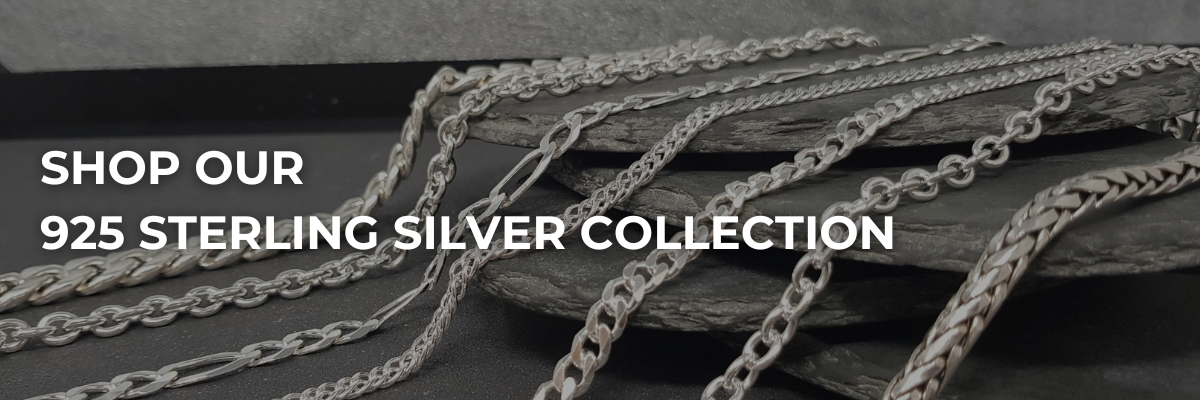
Sterling Silver vs Aluminium Jewellery: Which Is Better?
What Is Sterling Silver Jewellery?

Sterling silver jewellery consists of 92.5% silver and 7.5% other metals. Other metals in sterling silver include copper and nickel. Silver is often alloyed to form sterling silver, increasing its durability.
Pros- Easy to repair - silver is a soft and malleable metal. Jewellery made out of silver is easy to repair and just requires basic soldering to fix.
- Resistance to tarnishing and fading - compared to non-precious metals, sterling silver is very resistant to tarnishing and fading. This is because it contains minimal amounts of copper and nickel.
- Hypoallergenic - because sterling silver only contains small amounts of copper and nickel, it is less likely to cause skin allergies.
- Appearance - sterling silver is known for its bright white lustre. This gives jewellery made out of silver a luxurious look.
- Value - silver is considered a precious metal and tends to retain its value. This makes sterling silver jewellery more valuable than jewellery made of other materials.
Cons
- Expensive - sterling silver jewellery can be quite expensive. This is because silver is a precious metal.
- Heavier - compared to other silver metals, sterling silver can be quite heavy. For some, this weight may be uncomfortable for wearing jewellery daily.
- Durability - silver is a softer metal. Because of this, jewellery made using silver is more susceptible to scratches and dents.
- Maintenance requirements - sterling silver jewellery must be wiped and cleaned often to prevent its lustre from fading.
What Is Aluminium Jewellery?

Jewellery that is made of aluminium consists of bauxite. Bauxite is made up of mainly aluminium oxide and other metals. The quality of aluminium jewellery can vary based on the amount of aluminium oxide in the bauxite. Bauxite with more than 50% aluminium oxide is considered better quality.
Pros:
- Hypoallergenic - unlike other metals like brass or nickel, aluminium doesn’t cause skin allergies. This is because the metal has very low nickel and copper content.
- Resistant to tarnishing and fading - aluminium jewellery is resistant to losing its colour because of the natural aluminium oxide layer. This prevents the metal underneath from coming into contact with air and oxygen.
- Lightweight - jewellery made of aluminium tends to be very light. Aluminium jewellery makes for great everyday pieces.
- Easy to clean - it is fairly easy to clean aluminium jewellery. To remove oils and dirt, just wash in warm soapy water and dry with a soft cloth.
- Versatile - aluminium jewellery can come in a variety of colours when anodised. This natural oxide layer increases resistance to corrosion and wear but also allows for the absorption of dyes.
- Affordable - aluminium jewellery tends to be more affordable than other silver metals like white gold, rhodium and stainless steel. This is because of lower energy requirements for production. At the same time, aluminium is a non-precious metal.
- Recyclable - aluminium is more recyclable than precious metals like gold and silver. Aluminium as a material can be recycled an infinite amount of times and at low energy costs.
Cons
- Harder to repair - aluminium is less malleable than other silver metals. This can make it difficult for jewellers to solder.
- No value - aluminium jewellery has little to no value when compared to other silver metals like platinum, rhodium or sterling silver. This is because it is not a precious metal.
- Appearance - in comparison to other silver metals aluminium looks less shiny and more grey. This often means that aluminium jewellery lacks a luxurious appearance.
- Durability - aluminium is a much softer metal in comparison to other non-precious metals like stainless steel or brass. Jewellery made from aluminium is more prone to denting, scratches and warping due to high temperatures.
Differences Between Sterling Silver And Aluminium Jewellery
- Repairability - jewellery made of sterling silver is much easier to repair than aluminium jewellery. This is because silver is a more malleable metal than aluminium, allowing for easy soldering.
- Appearance - Sterling silver jewellery tends to be brighter and have a whiter appearance, whilst aluminium jewellery has a greyer and less shiny look.
- Value - sterling silver jewellery is more valuable than aluminium jewellery. This is because sterling silver is a precious metal.
- Price - jewellery made from sterling silver is more expensive than aluminium. This is because sterling silver is a precious metal.
- Weight - sterling silver jewellery tends to be much heavier than aluminium jewellery. This is because silver is a denser material than aluminium jewellery.
Sterling Silver vs Aluminium Jewellery: Which Is Better?
Whether sterling silver or aluminium jewellery is better for you will depend on your own preferences, budgets and styling needs.
Sterling silver is a great option for those who want a luxurious-looking jewellery piece that is easy to repair and retains its value. Aluminium jewellery is a better option for those who are looking for a more lightweight and affordable option.
Conclusion
After comparing sterling silver vs aluminium jewellery, you should have a better understanding of the pros and cons of each. The choice between these two types of silver jewellery depends on your preference, budget and styling needs.
Sterling silver has an iconic bright white appearance, a heavier feel and is easy to repair. Whilst aluminium jewellery has a greyer appearance and is much more affordable and lightweight.
Remember that when choosing between these two types of silver jewellery, you should choose whichever one compliments your style and how it makes you feel when you wear it.





Leave a comment
This site is protected by hCaptcha and the hCaptcha Privacy Policy and Terms of Service apply.